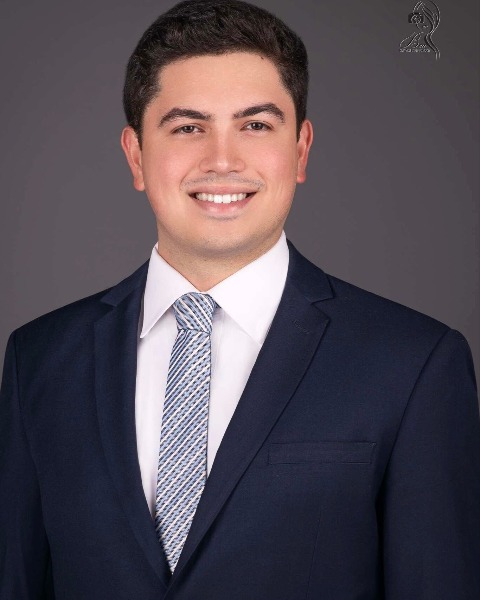Sunday Poster Session
Category: Esophagus
P0594 - Esophageal Perforation in Eosinophilic Esophagitis: A Systematic Review of Incidence, Risk Factors, and Management Outcomes
Sunday, October 26, 2025
3:30 PM - 7:00 PM PDT
Location: Exhibit Hall

Fernando Lugo-Hernandez, MD (he/him/his)
HCA Florida Healthcare
Brandon, FL
Presenting Author(s)
Fernando Lugo-Hernandez, MD, Bhavtosh Dedania, MD
HCA Florida Healthcare, Brandon, FL
Introduction: Esophageal perforation is a rare but serious complication of eosinophilic esophagitis (EoE), often resulting from food impaction or endoscopic intervention in the setting of undiagnosed or fibrostenotic disease. Despite its severity, the incidence, risk factors, and optimal management of EoE-associated perforation remain poorly characterized, with most data derived from isolated case reports. We conducted a systematic review to evaluate the clinical presentation, risk predictors, and outcomes of conservative versus surgical management.
Methods: We systematically searched PubMed, Embase, and Scopus from inception through January 2025 for studies reporting esophageal perforation in EoE. Inclusion criteria encompassed case reports, series, and observational studies with sufficient clinical detail. Data were extracted on demographics, mechanism of perforation (spontaneous vs. iatrogenic), risk factors, treatment approach, and outcomes. Results were synthesized qualitatively in accordance with PRISMA guidelines.
Results: Fifty publications involving 70 patients and 76 perforation events were included. Mean age was 34 years; 78% were male. Perforations were spontaneous in 60%—primarily due to vomiting after food impaction—and iatrogenic in 40%, mostly post-dilation or bolus push. Strictures were present in 60% of cases; food impaction was reported in 80% and strongly associated with perforation (OR ~14.9). In 73% of cases, patients had untreated or undiagnosed EoE at the time of perforation. Conservative management (bowel rest, antibiotics, PPIs) was successful in 67%, while 33% required surgery. No mortality was reported. Surgical cases had longer hospital stays (12–21 days) vs. conservative (7–10 days).
Discussion: Esophageal perforation in EoE is a rare but life-threatening event that most often affects patients with untreated or fibrostenotic disease. Our review identifies food impaction and esophageal stricture as the strongest risk factors, especially in those lacking active therapy. The predominance of spontaneous perforation following retching highlights the need for early diagnosis and dietary vigilance. Conservative management was effective in two-thirds of cases, supporting its use in stable patients with contained leaks. Surgical intervention, while required in select cases, also yielded excellent outcomes. These findings underscore the importance of early EoE recognition, careful endoscopic technique, and individualized management to reduce complication risk and optimize recovery.
Disclosures:
Fernando Lugo-Hernandez indicated no relevant financial relationships.
Bhavtosh Dedania indicated no relevant financial relationships.
Fernando Lugo-Hernandez, MD, Bhavtosh Dedania, MD. P0594 - Esophageal Perforation in Eosinophilic Esophagitis: A Systematic Review of Incidence, Risk Factors, and Management Outcomes, ACG 2025 Annual Scientific Meeting Abstracts. Phoenix, AZ: American College of Gastroenterology.
HCA Florida Healthcare, Brandon, FL
Introduction: Esophageal perforation is a rare but serious complication of eosinophilic esophagitis (EoE), often resulting from food impaction or endoscopic intervention in the setting of undiagnosed or fibrostenotic disease. Despite its severity, the incidence, risk factors, and optimal management of EoE-associated perforation remain poorly characterized, with most data derived from isolated case reports. We conducted a systematic review to evaluate the clinical presentation, risk predictors, and outcomes of conservative versus surgical management.
Methods: We systematically searched PubMed, Embase, and Scopus from inception through January 2025 for studies reporting esophageal perforation in EoE. Inclusion criteria encompassed case reports, series, and observational studies with sufficient clinical detail. Data were extracted on demographics, mechanism of perforation (spontaneous vs. iatrogenic), risk factors, treatment approach, and outcomes. Results were synthesized qualitatively in accordance with PRISMA guidelines.
Results: Fifty publications involving 70 patients and 76 perforation events were included. Mean age was 34 years; 78% were male. Perforations were spontaneous in 60%—primarily due to vomiting after food impaction—and iatrogenic in 40%, mostly post-dilation or bolus push. Strictures were present in 60% of cases; food impaction was reported in 80% and strongly associated with perforation (OR ~14.9). In 73% of cases, patients had untreated or undiagnosed EoE at the time of perforation. Conservative management (bowel rest, antibiotics, PPIs) was successful in 67%, while 33% required surgery. No mortality was reported. Surgical cases had longer hospital stays (12–21 days) vs. conservative (7–10 days).
Discussion: Esophageal perforation in EoE is a rare but life-threatening event that most often affects patients with untreated or fibrostenotic disease. Our review identifies food impaction and esophageal stricture as the strongest risk factors, especially in those lacking active therapy. The predominance of spontaneous perforation following retching highlights the need for early diagnosis and dietary vigilance. Conservative management was effective in two-thirds of cases, supporting its use in stable patients with contained leaks. Surgical intervention, while required in select cases, also yielded excellent outcomes. These findings underscore the importance of early EoE recognition, careful endoscopic technique, and individualized management to reduce complication risk and optimize recovery.
Disclosures:
Fernando Lugo-Hernandez indicated no relevant financial relationships.
Bhavtosh Dedania indicated no relevant financial relationships.
Fernando Lugo-Hernandez, MD, Bhavtosh Dedania, MD. P0594 - Esophageal Perforation in Eosinophilic Esophagitis: A Systematic Review of Incidence, Risk Factors, and Management Outcomes, ACG 2025 Annual Scientific Meeting Abstracts. Phoenix, AZ: American College of Gastroenterology.
